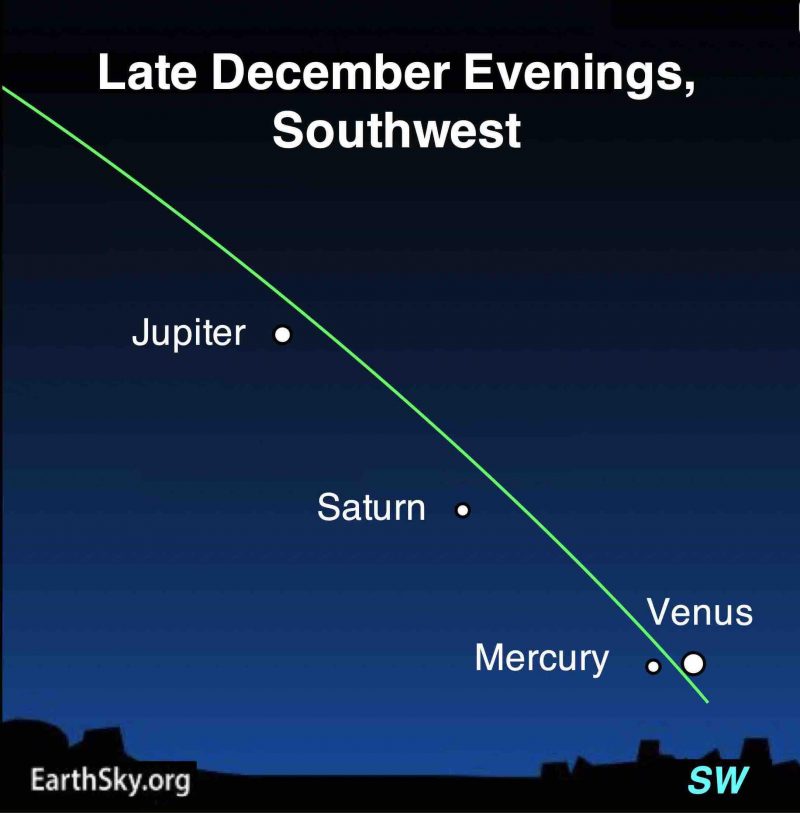
Watch for Mercury after sunset
The sun’s innermost planet, Mercury, is nowhere to be found for most of December 2021. It has been moving around the far side of the blinding sun, as seen from Earth. So it’s been crossing the sky with the sun during the day for us on Earth. But the last several evenings of 2021 may bring Mercury into view for you. Mercury has now moved out to one side of the sun from our early perspective. Its angular distance from the sun on our sky’s dome is increasing. So we should glimpse the planet, briefly, perhaps 30 minutes after sunset, in the sunset direction, in late December. You’ll need a sky that’s clear to the horizon in the sunset direction. And you’ll need to know just where to look. The chart above shows Mercury in relationship to Venus, Saturn and Jupiter in the western twilight.
And you have to look at the right time! Look soon after sunset. Mercury (and Venus) will soon follow the sun below the western horizon.
In late December, as Mercury comes into view, Venus will be almost gone from view, heading into the sunset glare, about to pass between us and the sun on January 9, 2022. Venus is bright, though, so you’ll spot it just above your western horizon. For us in the Northern Hemisphere, much-dimmer Mercury lies to the left of Venus. It might appear too faint to be easily noticed. Binoculars will be a great help in identifying this little world. If you spot them both, just imagine, in one view you’ll have seen the two closest planets to the sun!
For this event, Southern Hemisphere stargazers will have no better of a view than Northern Hemisphere observers. But hopefully we’ll all snag Mercury if we try!
Bottom line: Watch for Mercury as 2021 ends. Jupiter, Saturn and Venus will be strung out in a line in the western twilight sky. Mercury will be at the bottom of this line, near the sunset point.
Planet-observing is easy: Top tips here
EarthSky’s monthly planet guide: Visible planets and more
The post Watch for Mercury, too, as 2021 ends first appeared on EarthSky.
from EarthSky https://ift.tt/3qt6Yji

Watch for Mercury after sunset
The sun’s innermost planet, Mercury, is nowhere to be found for most of December 2021. It has been moving around the far side of the blinding sun, as seen from Earth. So it’s been crossing the sky with the sun during the day for us on Earth. But the last several evenings of 2021 may bring Mercury into view for you. Mercury has now moved out to one side of the sun from our early perspective. Its angular distance from the sun on our sky’s dome is increasing. So we should glimpse the planet, briefly, perhaps 30 minutes after sunset, in the sunset direction, in late December. You’ll need a sky that’s clear to the horizon in the sunset direction. And you’ll need to know just where to look. The chart above shows Mercury in relationship to Venus, Saturn and Jupiter in the western twilight.
And you have to look at the right time! Look soon after sunset. Mercury (and Venus) will soon follow the sun below the western horizon.
In late December, as Mercury comes into view, Venus will be almost gone from view, heading into the sunset glare, about to pass between us and the sun on January 9, 2022. Venus is bright, though, so you’ll spot it just above your western horizon. For us in the Northern Hemisphere, much-dimmer Mercury lies to the left of Venus. It might appear too faint to be easily noticed. Binoculars will be a great help in identifying this little world. If you spot them both, just imagine, in one view you’ll have seen the two closest planets to the sun!
For this event, Southern Hemisphere stargazers will have no better of a view than Northern Hemisphere observers. But hopefully we’ll all snag Mercury if we try!
Bottom line: Watch for Mercury as 2021 ends. Jupiter, Saturn and Venus will be strung out in a line in the western twilight sky. Mercury will be at the bottom of this line, near the sunset point.
Planet-observing is easy: Top tips here
EarthSky’s monthly planet guide: Visible planets and more
The post Watch for Mercury, too, as 2021 ends first appeared on EarthSky.
from EarthSky https://ift.tt/3qt6Yji

Aucun commentaire:
Enregistrer un commentaire